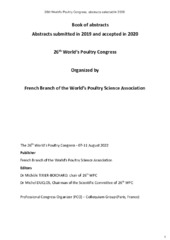Приказ основних података о документу
CAN ONE WEEK’S USE OF NETTLE IN BROILER FEED AFFECT THE CHEMICAL QUALITY OF MEAT?
| dc.creator | Lukić, Miloš | |
| dc.creator | Stanišić, Nikola | |
| dc.creator | Škrbić, Zdenka | |
| dc.creator | Petričević, Veselin | |
| dc.creator | Tolimir, Nataša | |
| dc.creator | Dosković, Vladimir | |
| dc.creator | Stamenić, Tamara | |
| dc.date.accessioned | 2023-11-09T08:51:18Z | |
| dc.date.available | 2023-11-09T08:51:18Z | |
| dc.date.issued | 2022-08 | |
| dc.identifier.uri | http://r.istocar.bg.ac.rs/handle/123456789/943 | |
| dc.description.abstract | This experiment aimed to evaluate the effects of adding fresh or dry nettle (Urtica dioica L.) to broiler diets during the last week of fattening on proximate composition, fatty acid and mineral content of meat. The trial was performed on a total of 600 ROSS-308 unsexed day-old chickens, divided into 3 groups (C - Control group; FN - Fresh Nettle group; DN - Dry Nettle group). All broilers were bred and fed equally, with standard diets from age 1-42 days, except for the last seven days of fattening when in FN group was added daily to the feeders (on top) 20g/chicken freshly collected, blanched and chopped nettle, or in case of DN group of broilers, 10g/kg finely ground dry nettle mixed into a finisher. On day 42, random sample of 6 male and 6 female birds were taken from each group and slaughtered. Meat samples (breasts and drumsticks) were collected and the proximate composition analysis was conducted on each portion of each chicken (total of 72 samples). The fatty acid composition (Shimadzu GC-2014 with FID detector) and mineral analysis (Na, Mg, K, Ca, Mn, Fe, Cu, Zn and Se content measured by iCap Q) was conducted on each portion (breast and drumstick) of 6 chicken per group (3 male and 3 female). An analysis of variance and t-test (IBM SPSS Statistics 20 software) was performed. Meat fat content was significantly lower (P=0.028) in broilers fed with the addition of dry nettle compared with other two groups, which could have an impact on quality characteristics of meat, such as flavor and tenderness. The addition of fresh or dry nettle influenced meat ash content as well, which was significantly larger compared with C group (P<0.001). Total MUFA was highest in DN group (31.20%), while there were no significant differences between other two groups (P<0.001), mainly due to higher share of palmitoleic and oleic acid found in meat from DN group. The lowest amount of total PUFA (35.08%) and n-6 fatty acids (32.19%) was found in DN group (P<0.001), specifically significantly lower content of linoleic acid. Also, DN group have better n-6/n-3 ratio (11.83) compared to control (13.46, P=0.036), while there was no effect when fresh nettle was used. Analysis of minerals in meat showed significantly higher level of Na and Se in DN group, and Fe and Zn in FN group. Generally, research shows that extra addition of 1% dry nettle in broiler feed during the last seven days of fattening can result in different chemical, fatty acid and mineral composition of meat. | sr |
| dc.language.iso | en | sr |
| dc.publisher | French Branch of the World’s Poultry Science Association | sr |
| dc.relation | info:eu-repo/grantAgreement/MESTD/inst-2020/200022/RS// | sr |
| dc.rights | openAccess | sr |
| dc.rights.uri | https://creativecommons.org/licenses/by/4.0/ | |
| dc.source | 26th World’s Poultry Congress, Book of abstracts | sr |
| dc.subject | broilers | sr |
| dc.subject | nettle | sr |
| dc.subject | feed | sr |
| dc.subject | meat quality | sr |
| dc.title | CAN ONE WEEK’S USE OF NETTLE IN BROILER FEED AFFECT THE CHEMICAL QUALITY OF MEAT? | sr |
| dc.type | conferenceObject | sr |
| dc.rights.license | BY | sr |
| dc.citation.spage | 465 | |
| dc.citation.epage | 465 | |
| dc.identifier.rcub | https://hdl.handle.net/21.15107/rcub_ristocar_943 | |
| dc.identifier.fulltext | http://r.istocar.bg.ac.rs/bitstream/id/4448/bitstream_4448.pdf | |
| dc.type.version | publishedVersion | sr |


